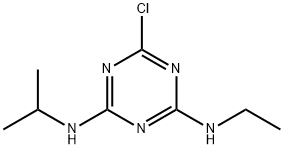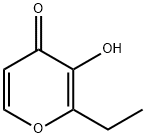AtrazineinMethanol , 1000μg/mL , 1912-24-9
Synonym(s):
2-Chloro-4-ethylamino-6-isopropylamino-1,3,5-triazine
CAS NO.:1912-24-9
Empirical Formula: C8H14ClN5
Molecular Weight: 215.68
MDL number: MFCD00041810
EINECS: 217-617-8
| Pack Size | Price | Stock | Quantity |
| 1.2ml | RMB559.20 | In Stock |
|
| others | Enquire |
PRODUCT Properties
| Melting point: | 175°C |
| Boiling point: | 200°C |
| Density | 1.187 |
| vapor pressure | 0Pa at 25℃ |
| refractive index | 1.6110 (estimate) |
| Flash point: | 11 °C |
| storage temp. | Keep in dark place,Inert atmosphere,Room temperature |
| solubility | DMSO: 83.33 mg/mL (386.36 mM) |
| pka | pKa 1.64 (Uncertain) |
| form | Crystalline |
| color | Crystals |
| Water Solubility | Slightly soluble. 0.007 g/100 mL |
| Merck | 14,871 |
| BRN | 612020 |
| Exposure limits | OSHA PEL: TWA 5 mg/m3; ACGIH TLV: TWA 5 mg/m3. |
| Stability: | Stable. Incompatible with strong oxidizing agents. |
| LogP | 2.59 at 20℃ and pH7.31-7.51 |
| Surface tension | 57.6mN/m at 30mg/L and 21℃ |
| Dissociation constant | 1.56 at 20℃ |
| CAS DataBase Reference | 1912-24-9(CAS DataBase Reference) |
| IARC | 3 (Vol. 53, 73) 1999 |
| NIST Chemistry Reference | Atrazine(1912-24-9) |
| EPA Substance Registry System | Atrazine (1912-24-9) |
Description and Uses
A major effort in evaluating the toxicity of the triazines is the
cumulative risk assessment (CRA) conducted by US Environmental
Protection Agency (EPA) as part of the tolerance reassessment
process under the Food Quality Protection Act
(FQPA) of 1996. The CRA (released 2006) was conducted for
triazines as a common mechanism group (CMG), determined
to have a ‘common mechanism of toxicity’ in acting the same
way in the body, that is, the same toxic effect occurs in the same
organ or tissue by essentially the same sequence of major
biochemical events. EPA determined that atrazine, simazine,
propazine, and the metabolites desethyl-s-atrazine (DEA),
desisopropyl-s-atrazine (DIA), and diaminochlorotriazine
(DACT) are considered as a CMG due to their ability to cause
neuroendocrine- and endocrine-related developmental, reproductive,
and carcinogenic effects. Other triazines, such as
ametryn, prometryn, prometon, metsulfuron methyl, trisulfuron,
chlorsulfuron, and DPX-M6316, were excluded
because these triazines do not share the toxicity profile of the
CMG triazines. Hydroxyatrazine was excluded based on the
lack of mammary tumor induction and no compelling
evidence of neuroendocrine-related toxicity. Propazine was
excluded from the cumulative assessment group (CAG)
because exposures to propazine are not anticipated via any of
the relevant exposure pathways. Therefore, the cumulative
assessment included only atrazine, simazine, DEA, DIA, and
DACT, referred to as ‘triazine residues.’
For the triazines, the major toxicity of concern involves the
neuroendocrine system with the key toxicity mechanism being
luteinizing hormone (LH)-dependent effects. The changes in
circulating endocrine hormones regardless of rat strain is the
basis for assuming commonality of mechanism, which were
noted in the same range of doses for these triazines.
The relevance of the induction of mammary tumors in
female Sprague–Dawley (SD) rats to humans continues to
be a subject of discussion and research on the endocrine
effects of triazines. Another consideration is whether the
chemicals’ effects on endocrine responses have an impact on reproduction, development, and the brain related or unrelated
to carcinogenesis. Significant research into the mechanism of
mammary tumor formation was conducted in which the effects
of atrazine, simazine, and other triazines were studied on estrus
cycle, estrogen-mediated responses, estrogen receptor binding,
and hormonal induction and metabolism in several species,
but mostly in the rat. Both the in vivo and in vitro data suggest
that atrazine and simazine disrupt ovarian cycling and induce
mammary tumors in female SD rates, and alteration of the
estrous state is directly associated with the incidence of
mammary tumors.
Atrazine and its metabolites appear to affect reproductive
function of the male as well as the female reproductive and
development parameters. However, they have not been tested
with exposure at all critical periods of development in the
young, evaluated in standard guideline neurotoxicity assay, and
the earlier reproductive toxicity studies did not include sensitive
measures of endocrine disruption that are now included.
Additional studies have been published since the CRA in 2006.
The US EPA FIFRA panel reevaluated the database and reaffirmed
the conclusion on the toxicity of the triazines and the
mammary tumor determination in 2010.
Preemergence and postemergence herbicide for control of some annual grasses and broad-leaved weeds in corn, fallow land, rangeland, sorghum, non-cropland, certain trop ical plantations, evergreen nurseries, fruit crops and lawns.
Safety
| Symbol(GHS) |    GHS07,GHS08,GHS09 |
| Signal word | Warning |
| Hazard statements | H317-H373-H410 |
| Precautionary statements | P260-P272-P273-P280-P302+P352-P314 |
| Hazard Codes | Xn;N,N,Xn,T,F,Xi |
| Risk Statements | 43-48/22-50/53-39/23/24/25-23/24/25-11-38-36/37/38-20/21/22-52/53 |
| Safety Statements | 2-36/37-60-61-45-16-7-36-26 |
| RIDADR | 3077 |
| OEB | B |
| OEL | TWA: 5 mg/m3 |
| WGK Germany | 3 |
| RTECS | XY5600000 |
| HazardClass | 9 |
| PackingGroup | III |
| HS Code | 29336990 |
| Hazardous Substances Data | 1912-24-9(Hazardous Substances Data) |
| Toxicity | LD50 orally in mice: 1750 mg/kg (Dalgaard-Mikkelsen, Poulsen) |




